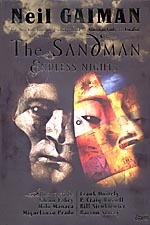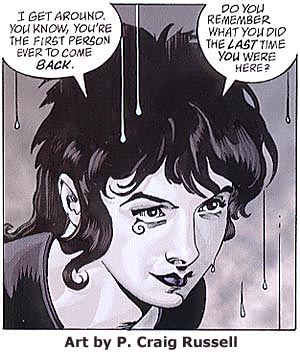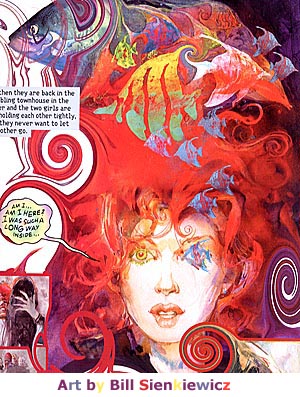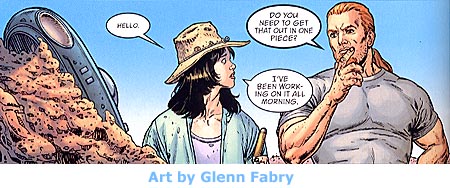 Written by Neil Gaiman
Written by Neil Gaiman
Art by Glenn Fabry, Milo Manara, Miguelanxo Prado, Frank Quitely, P. Craig Russell, Bill Sienkiewicz, and Barron Storey
160 pages, color
Published by Vertigo/DC Comics
Fans of Sandman had to be happy when they first heard the news. The best-selling series, having ended in 1996 with its 75-issue run, was returning in the form of a brand-new graphic novel written by Neil Gaiman. Sandman: Endless Nights certainly set sales records thanks to high demand in both comic shops and bookstores—but once all the flurry dies down, how is the book itself?
 Containing seven stories, one for each member of the family of Endless, Sandman: Endless Nights begins with P. Craig Russell’s contribution, “Death and Venice”. It reads almost like one hesitantly entering unfamiliar water at a swimming pool, cautiously sticking a toe in to see if all is well. Gaiman’s story goes through its paces with an uncharacteristic predictability of a Venetian Count and his court on an island in Venice who cannot die because their day will never end. Aside from a very small end note of surprise, this opening is carried not by its writing, but by Russell’s art. The only artist with whom Gaiman had collaborated with in the past, Russell draws every panel as if it’s a work of art, with delicate and graceful lines forming archways, masks, and elephants with the greatest of ease. I don’t think many people are going to be heavily re-reading “Death and Venice”, but they will be going back to stare at what Russell created for Gaiman.
Containing seven stories, one for each member of the family of Endless, Sandman: Endless Nights begins with P. Craig Russell’s contribution, “Death and Venice”. It reads almost like one hesitantly entering unfamiliar water at a swimming pool, cautiously sticking a toe in to see if all is well. Gaiman’s story goes through its paces with an uncharacteristic predictability of a Venetian Count and his court on an island in Venice who cannot die because their day will never end. Aside from a very small end note of surprise, this opening is carried not by its writing, but by Russell’s art. The only artist with whom Gaiman had collaborated with in the past, Russell draws every panel as if it’s a work of art, with delicate and graceful lines forming archways, masks, and elephants with the greatest of ease. I don’t think many people are going to be heavily re-reading “Death and Venice”, but they will be going back to stare at what Russell created for Gaiman.
Next up is Milo Manara and “What I’ve Tasted of Desire”. Manara is such a perfect choice for a story about desire, and sex, and battles. In many ways, Manara’s art defines the word “lush”, with sensually painted men and women draped across the pages. It’s strange, then, that this is a curiously cold story; as a reader I was unable to find a hook in the story to keep my interest up. Desire may inflame those she touches, but to a passerby it’s heartless. Much more to my liking was Miguelanxo Prado’s tackling of “The Heart of a Star”, Gaiman’s Dream story. It’s funny, because “The Heart of a Star” is the one entry here full of sly nods and references to other stories, with lots of things to appeal to knowledgeable fans of the series, but despite it all it’s the most entrancing story to date. At the heart of the story is a story of love and understandings, and Gaiman’s able to entertain both the hardcore Sandman fan (appearances by Delight and the original Despair, Dream’s friendship with Desire, and so forth) and the casual reader. Prado’s art brings the fantastic to life here, with gorgeous paintings of the conference center floating in space as well as its inhabitants. After seeing Prado work on mundane screwball jokes, it’s fantastic to see him really cut loose here and show American audiences just what else he’s made of.
 Certainly not to everyone’s tastes will be Gaiman’s writing for Barron Storey on “15 Portraits of Despair”. It is, as the title indicates, fifteen portraits of Despair as well as those who are in her domain. It’s not a traditional story by any stretch of the imagination, a series of vignettes that really define who Despair is and what she does to those that she touches. It’s a haunting series of short pieces based on the writing alone, but Storey’s illustrations propel “15 Portraits of Despair” into a near-necessity for the overall makeup of Sandman: Endless Nights. Storey’s art (with designs by Dave McKean) is a series of dark and disturbing multimedia explosions, using anything and everything necessary to bring each vision to life. It’s fascinating to look at how Storey creates each work, as well as see the influence that he’s had on so many other artists over the years.
Certainly not to everyone’s tastes will be Gaiman’s writing for Barron Storey on “15 Portraits of Despair”. It is, as the title indicates, fifteen portraits of Despair as well as those who are in her domain. It’s not a traditional story by any stretch of the imagination, a series of vignettes that really define who Despair is and what she does to those that she touches. It’s a haunting series of short pieces based on the writing alone, but Storey’s illustrations propel “15 Portraits of Despair” into a near-necessity for the overall makeup of Sandman: Endless Nights. Storey’s art (with designs by Dave McKean) is a series of dark and disturbing multimedia explosions, using anything and everything necessary to bring each vision to life. It’s fascinating to look at how Storey creates each work, as well as see the influence that he’s had on so many other artists over the years.
One of Storey’s students was Bill Sienkiewicz, making it appropriate that Sienkiewicz is next with the Delirium piece “Going Inside”. Gaiman’s story here is a quiet twisting of an idea into something very different, so you can’t really see the beginning or the end until you’ve completed the entire journey and its madness suddenly makes perfect sense. Gaiman and Sienkiewicz truly bring across the idea of Delirium here, with gorgeous painted art and lines about JFK merging seamlessly into a solitary vision. It’s hard to imagine an extended narrative about Delirium being easy to follow, and I think the lack of an initial straightforward story is going to scare off a lot of readers, but this short piece worked perfectly for me.
Those terrified by the last two pieces will no doubt be relieved that “On the Peninsula” is a bit more straightforward. Glenn Fabry’s macho art is a wonderful choice for a story about Destruction, as the prodigal Endless’s sphere of influence brings a possible future of war and technology to an isolated location. The idea of archaeologists digging up the future is always an interesting one, and while the main story itself wraps up a little too neatly to be terribly memorable, Gaiman’s character of Rachel is one that will stick with you, with her dreams of destruction and attraction to a member of the Endless. Almost as strong is how Fabry draws Destruction here; unlike his previous appearances (thanks to artists like Jill Thompson and Bryan Talbot), you truly get the impression here of Destruction’s presence, both physically and mentally. Here he’s an awesome force of nature, which is exactly how he should come across to the reader. Future stories of Destruction, whenever they happen, will certainly be drawing on Fabry’s work here.

Sandman: Endless Nights closes out with a coda about Destiny, fully painted by Frank Quitely. It’s not really a story—it would certainly be difficult to have a protagonist who knows everything that will happen carry one—but a wrapping up of the book as a whole. Quitely’s art is the nicest I’ve ever seen here; each page contains an amazing amount of detail, from the hairs on Destiny’s hands to each individual fly buzzing around a corpse. It’s a nice way to close out the book, with a step backwards to see the full scope of the Endless one final time.
While some entries have more to offer than others, each story in Sandman: Endless Nights has something to recommend to the reader. It’s great to see Gaiman return if only briefly to the characters he created some time ago, and to remind its readers why they’d fallen in love with the series the first time around. Hopefully this will herald the start of a regular series of visits back to the world of the Endless. If a four year gap between graphic novels is what it takes to get something of this quality, I for one am willing to wait. Sweet dreams, dear readers.
Purchase Links:
